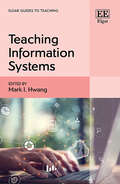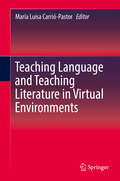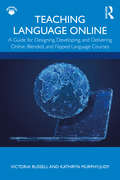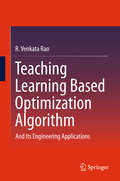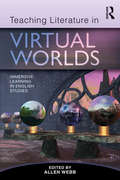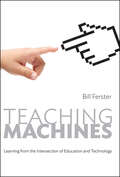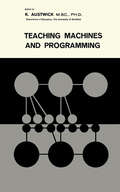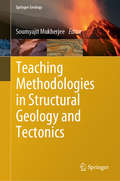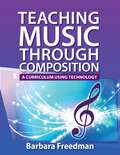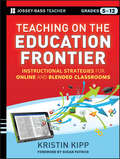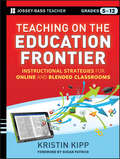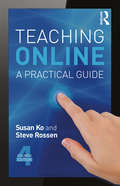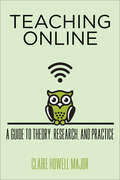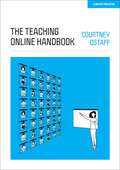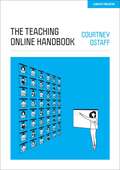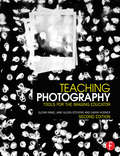- Table View
- List View
Teaching Information Systems (Elgar Guides to Teaching)
Issues related to teaching and learning information systems (IS) concepts have received keen interest from IS academics since the discipline’s inception over 60 years ago. Bringing together cutting-edge research from over 30 international experts, Teaching Information Systems presents a timely assessment of critical issues associated with the IS curriculum, the learner, and the learning environment.Chapters take a contemporary look at the key issues related to the teaching of IS across the globe, addressing the challenges of virtual learning environments, the drawbacks of relying solely on textbooks, and current thinking on how to align the curriculum with industry needs. Drawing lessons from faculty reflection and empirical evidence, the book provides valuable insight to IS professors and administrators invested in delivering high-quality IS education, demonstrating how instructors can design and implement a relevant and practical curriculum to meet the needs of modern-day students.Exploring non-technical skills and non-traditional instructional materials, this erudite teaching guide will prove an essential resource for instructors in information systems, computer science, information science, and related disciplines. Its practical insights will also benefit researchers and consultants interested in applying IS research findings to practice.
Teaching Language and Teaching Literature in Virtual Environments
by María Luisa Carrió-PastorThis book sheds new light on language and literature teaching, and offers examples of teaching language in virtual environments. Providing an overview of virtual environments for teaching, it also includes chapters devoted to methodology design for second language teaching in these environments. Further it describes tools for second/ foreign language teaching and proposals for specific second language teaching in virtual environments. Lastly, it presents experiments on literature teaching in virtual environments and discusses the future of technology in education. With interdisciplinary appeal, the book is a particularly valuable resource for scholars with an interest in technology, language teaching and literature teaching.
Teaching Language Online: A Guide for Designing, Developing, and Delivering Online, Blended, and Flipped Language Courses
by Victoria Russell Kathryn Murphy-JudyPractical and accessible, this book comprehensively covers everything you need to know to design, develop, and deliver successful online, blended, and flipped language courses. Grounded in the principles of instructional design and communicative language teaching, this book serves as a compendium of best practices, research, and strategies for creating learner-centered online language instruction that builds students’ proficiency within meaningful cultural contexts. This book addresses important topics such as finding and optimizing online resources and materials, learner engagement, teacher and student satisfaction and connectedness, professional development, and online language assessment. Teaching Language Online features: A step-by-step guide aligned with the American Council on the Teaching of Foreign Languages (ACTFL), the Common European Framework of Reference (CEFR) for Languages: Learning, Teaching and Assessment, and the World-Class Instructional Design and Assessment (WIDA) standards Research-based best practices and tools to implement effective communicative language teaching (CLT) online Strategies and practices that apply equally to world languages and ESL/EFL contexts Key takeaway summaries, discussion questions, and suggestions for further reading in every chapter Free, downloadable eResources with further readings and more materials available at www.routledge.com/ 9781138387003 As the demand for language courses in online or blended formats grows, K-16 instructors urgently need resources to effectively transition their teaching online. Designed to help world language instructors, professors, and K-12 language educators regardless of their level of experience with online learning, this book walks through the steps to move from the traditional classroom format to effective, successful online teaching environments.
Teaching Language Online: A Guide for Designing, Developing, and Delivering Online, Blended, and Flipped Language Courses
by Victoria Russell Kathryn Murphy-JudyPractical and accessible, this book comprehensively covers everything you need to know to design, develop, and deliver successful online, blended, and flipped language courses. Grounded in the principles of instructional design and communicative language teaching, this book serves as a compendium of best practices, research, and strategies for creating learner-centered online language instruction that builds students’ proficiency within meaningful cultural contexts. This book addresses important topics such as finding and optimizing online resources and materials, learner engagement, teacher and student satisfaction and connectedness, professional development, and online language assessment. Teaching Language Online features: A step-by-step guide aligned with the American Council on the Teaching of Foreign Languages (ACTFL), the Common European Framework of Reference (CEFR) for Languages: Learning, Teaching and Assessment, and the World-Class Instructional Design and Assessment (WIDA) standards Research-based best practices and tools to implement effective communicative language teaching (CLT) online Strategies and practices that apply equally to world languages and ESL/EFL contexts Key takeaway summaries, discussion questions, and suggestions for further reading in every chapter Free, downloadable eResources with further readings and more materials available at www.routledge.com/ 9781138387003 As the demand for language courses in online or blended formats grows, K-16 instructors urgently need resources to effectively transition their teaching online. Designed to help world language instructors, professors, and K-12 language educators regardless of their level of experience with online learning, this book walks through the steps to move from the traditional classroom format to effective, successful online teaching environments.
Teaching Learning Based Optimization Algorithm: And Its Engineering Applications
by R. Venkata RaoDescribing a new optimization algorithm, the “Teaching-Learning-Based Optimization (TLBO),” in a clear and lucid style, this book maximizes reader insights into how the TLBO algorithm can be used to solve continuous and discrete optimization problems involving single or multiple objectives. As the algorithm operates on the principle of teaching and learning, where teachers influence the quality of learners’ results, the elitist version of TLBO algorithm (ETLBO) is described along with applications of the TLBO algorithm in the fields of electrical engineering, mechanical design, thermal engineering, manufacturing engineering, civil engineering, structural engineering, computer engineering, electronics engineering, physics and biotechnology. The book offers a valuable resource for scientists, engineers and practitioners involved in the development and usage of advanced optimization algorithms.
Teaching & Learning Online: New Pedagogies for New Technologies
by John StephensonA guide to teaching and learning online. It presents a wide range of experience and research findings from leading practitioners and organizations around the world, including case studies from the Open University, the BBC, ICL and leading international academics.
Teaching & Learning Online: New Pedagogies for New Technologies (Creating Success Ser.)
by John StephensonA guide to teaching and learning online. It presents a wide range of experience and research findings from leading practitioners and organizations around the world, including case studies from the Open University, the BBC, ICL and leading international academics.
Teaching Literature in Virtual Worlds: Immersive Learning in English Studies
by Allen WebbWhat are the realities and possibilities of utilizing on-line virtual worlds as teaching tools for specific literary works? Through engaging and surprising stories from classrooms where virtual worlds are in use, this book invites readers to understand and participate in this emerging and valuable pedagogy. It examines the experience of high school and college literature teachers involved in a pioneering project to develop virtual worlds for literary study, detailing how they created, utilized, and researched different immersive and interactive virtual reality environments to support the teaching of a wide range of literary works. Readers see how students role-play as literary characters, extending and altering character conduct in purposeful ways ,and how they explore on-line, interactive literature maps, museums, archives, and game worlds to analyze the impact of historical and cultural setting, language, and dialogue on literary characters and events. This book breaks exciting ground, offering insights, pedagogical suggestions, and ways for readers to consider the future of this innovative approach to teaching literary texts.
Teaching Literature in Virtual Worlds: Immersive Learning in English Studies
by Allen WebbWhat are the realities and possibilities of utilizing on-line virtual worlds as teaching tools for specific literary works? Through engaging and surprising stories from classrooms where virtual worlds are in use, this book invites readers to understand and participate in this emerging and valuable pedagogy. It examines the experience of high school and college literature teachers involved in a pioneering project to develop virtual worlds for literary study, detailing how they created, utilized, and researched different immersive and interactive virtual reality environments to support the teaching of a wide range of literary works. Readers see how students role-play as literary characters, extending and altering character conduct in purposeful ways ,and how they explore on-line, interactive literature maps, museums, archives, and game worlds to analyze the impact of historical and cultural setting, language, and dialogue on literary characters and events. This book breaks exciting ground, offering insights, pedagogical suggestions, and ways for readers to consider the future of this innovative approach to teaching literary texts.
Teaching Machines: Learning from the Intersection of Education and Technology (Tech.edu: A Hopkins Series on Education and Technology)
by Bill FersterThe allure of educational technology is easy to understand. Classroom instruction is an expensive and time-consuming process fraught with contradictory theories and frustratingly uneven results. Educators, inspired by machines’ contributions to modern life, have been using technology to facilitate teaching for centuries.In Teaching Machines, Bill Ferster examines past attempts to automate instruction from the earliest use of the postal service for distance education to the current maelstrom surrounding Massive Open Online Courses. He tells the stories of the entrepreneurs and visionaries who, beginning in the colonial era, developed and promoted various instructional technologies. Ferster touches on a wide range of attempts to enhance the classroom experience with machines, from hornbooks, the Chautauqua movement, and correspondence courses to B. F. Skinner’s teaching machine, intelligent tutoring systems, and eLearning. The famed progressive teachers, researchers, and administrators that the book highlights often overcame substantial hurdles to implement their ideas, but not all of them succeeded in improving the quality of education. Teaching Machines provides invaluable new insight into our current debate over the efficacy of educational technology.
Teaching Machines: Learning from the Intersection of Education and Technology (Tech.edu: A Hopkins Series on Education and Technology)
by Bill FersterThe allure of educational technology is easy to understand. Classroom instruction is an expensive and time-consuming process fraught with contradictory theories and frustratingly uneven results. Educators, inspired by machines’ contributions to modern life, have been using technology to facilitate teaching for centuries.In Teaching Machines, Bill Ferster examines past attempts to automate instruction from the earliest use of the postal service for distance education to the current maelstrom surrounding Massive Open Online Courses. He tells the stories of the entrepreneurs and visionaries who, beginning in the colonial era, developed and promoted various instructional technologies. Ferster touches on a wide range of attempts to enhance the classroom experience with machines, from hornbooks, the Chautauqua movement, and correspondence courses to B. F. Skinner’s teaching machine, intelligent tutoring systems, and eLearning. The famed progressive teachers, researchers, and administrators that the book highlights often overcame substantial hurdles to implement their ideas, but not all of them succeeded in improving the quality of education. Teaching Machines provides invaluable new insight into our current debate over the efficacy of educational technology.
Teaching Machines and Programming
by K. AustwickTeaching Machines and Programming covers the significant developments in teaching machines and automated teaching, as well as the major theoretical issues and attributes involved in these procedures. After a brief introduction to teaching machine procedures, this six-chapter text goes on summarizing the industrial and military applications of teaching machines. The succeeding chapters consider the underlying theory, function, and schema of the adaptive teaching system, which are related to recognizable teaching functions performed by a human tutor. The last chapters discuss the development and features of linear programs and their application as new teaching aid. These chapters also look into some practical problems arising in programming for schools. This book will prove useful to computer programmers, school administrators, teachers, and students.
Teaching Methodologies in Structural Geology and Tectonics (Springer Geology)
by Soumyajit MukherjeeThis edited book discusses various challenges in teaching structural geology and tectonics and how they have been overcome by eminent instructors, who employed effective and innovative means to do so. All of the chapters were written by prominent and active academics and geoscientists fully engaged in teaching Structural Geology and Tectonics. New instructors will find this book indispensible in framing their teaching strategy. Effective teaching of Structural Geology and Tectonics constitutes the backbone of geoscience education. Teaching takes place not only in classrooms, but also in labs and in the field. The content and teaching methodologies for these two fields have changed over time, shaped by the responsibilities that present-day geoscientists are expected to fulfill.
Teaching Music Through Composition: A Curriculum Using Technology
by Barbara FreedmanTeaching Music through Composition offers a practical, fully multimedia curriculum designed to teach basic musical concepts through the creative process of music composition. Author and award-winning music educator Barbara Freedman presents classroom-tested ways of teaching composition with technology as a tool with which students can create, edit, save, and reproduce music. As Freedman demonstrates, technology allows a musical experience for all skill levels in opportunities never before available to compose manipulate, instantly listen to music electronically and even print standard Western music notation for others to play without having to know much about traditional music theory or notation. All students can have meaningful hands-on applied learning experiences that will impact not only their music experience and learning but also their understanding and comfort with 21st century technology. Whether the primary focus of your class is to use technology to create music or to explore using technology in a unit or two, this book will show you how it can be done with practical, tried-and-true lesson plans and student activities.
Teaching Music Through Composition: A Curriculum Using Technology
by Barbara FreedmanTeaching Music through Composition offers a practical, fully multimedia curriculum designed to teach basic musical concepts through the creative process of music composition. Author and award-winning music educator Barbara Freedman presents classroom-tested ways of teaching composition with technology as a tool with which students can create, edit, save, and reproduce music. As Freedman demonstrates, technology allows a musical experience for all skill levels in opportunities never before available to compose manipulate, instantly listen to music electronically and even print standard Western music notation for others to play without having to know much about traditional music theory or notation. All students can have meaningful hands-on applied learning experiences that will impact not only their music experience and learning but also their understanding and comfort with 21st century technology. Whether the primary focus of your class is to use technology to create music or to explore using technology in a unit or two, this book will show you how it can be done with practical, tried-and-true lesson plans and student activities.
Teaching Of Computer Science
by P.N. Lakshmi ShanmugamThis book has been written as a basic textbook for B.Ed student teachers who have chosen one of the optional subjects as computer science -I studying in the B.Ed colleges affiliated to Tamil Nadu Teachers Education University. The importance of systematic and organized knowledge can hardly be exaggerated in this book. Ten chapters namely Hardware and Software, Aims of Teaching Computer Science, Micro-teaching, Lesson Plan and Unit Plan, Methods of Teaching. Teaching Aids. Curriculum, Evaluation in Education, Textbook, Assignment and Review are described in a simple language with images and necessary illustrations to enable the student teachers to understand it clearly and easily. It highlights skills and values for everyday use based upon Bloom's taxonomy of educational objectives. A complete and detailed description of computer science library is helpful to the students in stimulating the ideas about digital library. Greater emphasis is given to the use of different types of tests and construction of Achievement test towards the improvement of learning and instruction.
Teaching on the Education Frontier: Instructional Strategies for Online and Blended Classrooms Grades 5-12
by Kristin KippA groundbreaking guide to facilitating online and blended courses This comprehensive resource offers teachers in grades K-12 a hands-on guide to the rapidly growing field of online and blended teaching. With clear examples and explanations, Kristin Kipp shows how to structure online and blended courses for student engagement, build relationships with online students, facilitate discussion boards, collaborate online, design online assessments, and much more. Shows how to create a successful online or blended classroom Illustrates the essential differences between face-to-face instruction and online teaching Foreword by Susan Patrick of the International Association for K-12 Online Learning This is an essential handbook for learning how to teach online and improve student achievement.
Teaching on the Education Frontier: Instructional Strategies for Online and Blended Classrooms Grades 5-12
by Kristin KippA groundbreaking guide to facilitating online and blended courses This comprehensive resource offers teachers in grades K-12 a hands-on guide to the rapidly growing field of online and blended teaching. With clear examples and explanations, Kristin Kipp shows how to structure online and blended courses for student engagement, build relationships with online students, facilitate discussion boards, collaborate online, design online assessments, and much more. Shows how to create a successful online or blended classroom Illustrates the essential differences between face-to-face instruction and online teaching Foreword by Susan Patrick of the International Association for K-12 Online Learning This is an essential handbook for learning how to teach online and improve student achievement.
Teaching Online: A Practical Guide
by Susan Ko Steve RossenTeaching Online: A Practical Guide is an accessible, introductory, and comprehensive guide for anyone who teaches online. The fourth edition of this bestselling resource has been fully revised, maintains its reader-friendly tone, and offers exceptional practical advice, new teaching examples, faculty interviews, and an updated resource section. New to this edition: entire new chapter on MOOCs (massive open online courses); expanded information on teaching with mobile devices, using open educational resources, and learning analytics; additional interviews with faculty, case studies, and examples; spotlight on new tools and categories of tools, especially multimedia. Focusing on the "hows" and "whys" of implementation rather than theory, the fourth edition of Teaching Online is a must-have resource for anyone teaching online or thinking about teaching online.
Teaching Online: A Practical Guide (College Teaching Ser.)
by Susan Ko Steve RossenTeaching Online: A Practical Guide is an accessible, introductory, and comprehensive guide for anyone who teaches online. The fourth edition of this bestselling resource has been fully revised, maintains its reader-friendly tone, and offers exceptional practical advice, new teaching examples, faculty interviews, and an updated resource section. New to this edition: entire new chapter on MOOCs (massive open online courses); expanded information on teaching with mobile devices, using open educational resources, and learning analytics; additional interviews with faculty, case studies, and examples; spotlight on new tools and categories of tools, especially multimedia. Focusing on the "hows" and "whys" of implementation rather than theory, the fourth edition of Teaching Online is a must-have resource for anyone teaching online or thinking about teaching online.
Teaching Online: A Guide to Theory, Research, and Practice (Tech.edu: A Hopkins Series on Education and Technology)
by Claire Howell MajorIt is difficult to imagine a college class today that does not include some online component�whether a simple posting of a syllabus to course management software, the use of social media for communication, or a full-blown course offering through a MOOC platform. In Teaching Online, Claire Howell Major describes for college faculty the changes that accompany use of such technologies and offers real-world strategies for surmounting digital teaching challenges.Teaching with these evolving media requires instructors to alter the ways in which they conceive of and do their work, according to Major. They must frequently update their knowledge of learning, teaching, and media, and they need to develop new forms of instruction, revise and reconceptualize classroom materials, and refresh their communication patterns. Faculty teaching online must also reconsider the student experience and determine what changes for students ultimately mean for their own work and for their institutions. Teaching Online presents instructors with a thoughtful synthesis of educational theory, research, and practice as well as a review of strategies for managing the instructional changes involved in teaching online. In addition, this book presents examples of best practices from successful online instructors as well as cutting-edge ideas from leading scholars and educational technologists. Faculty members, researchers, instructional designers, students, administrators, and policy makers who engage with online learning will find this book an invaluable resource.
The Teaching Online Handbook
by Courtney OstaffClassroom teachers are increasingly expected to teach online – creating content area courses from scratch with little support or training. But high-quality, researched-based online teaching has its own particular set of skills and expectations, and most resources are directed at college-level instructors. This no-nonsense handbook is for that busy classroom teacher, with clear techniques for planning, instruction, and assessment, as well as sections on teaching students with diverse needs and exceptionalities. Based on the author's real-life experiences as an online teacher, there are multiple examples including sample assignments across content areas, rubrics for grading, and sample scripts for parent contact as well as tips to reduce instructor workload and conduct successful live instruction.
The Teaching Online Handbook
by Courtney OstaffClassroom teachers are increasingly expected to teach online - creating content area courses from scratch with little support or training. But high-quality, researched-based online teaching has its own particular set of skills and expectations, and most resources are directed at college-level instructors. This no-nonsense handbook is for that busy classroom teacher, with clear techniques for planning, instruction, and assessment, as well as sections on teaching students with diverse needs and exceptionalities. Based on the author's real-life experiences as an online teacher, there are multiple examples including sample assignments across content areas, rubrics for grading, and sample scripts for parent contact as well as tips to reduce instructor workload and conduct successful live instruction.
Teaching Photography: Tools for the Imaging Educator (Photography Educators Series)
by Glenn Rand Jane Alden Stevens Garin HornerThe photographic community is rife with talented and creative practitioners and artists. But making great photographs does not always translate into an ability to teach effectively. This new edition of Teaching Photography approaches photographic education from a point of view that stresses the how and why of the education. It includes the resources that will inspire new and seasoned teachers to help students expand their technical and aesthetic abilities and techniques, as well as their visual literacy and the way photography fits into the wider world. Fully updated to include the online/hybrid classroom environment, collaborative learning, rubrics, and using digital technology, plus techniques for inspiring conversations and critiques.
Teaching Photography: Tools for the Imaging Educator (Photography Educators Series)
by Glenn Rand Jane Alden Stevens Garin HornerThe photographic community is rife with talented and creative practitioners and artists. But making great photographs does not always translate into an ability to teach effectively. This new edition of Teaching Photography approaches photographic education from a point of view that stresses the how and why of the education. It includes the resources that will inspire new and seasoned teachers to help students expand their technical and aesthetic abilities and techniques, as well as their visual literacy and the way photography fits into the wider world. Fully updated to include the online/hybrid classroom environment, collaborative learning, rubrics, and using digital technology, plus techniques for inspiring conversations and critiques.
